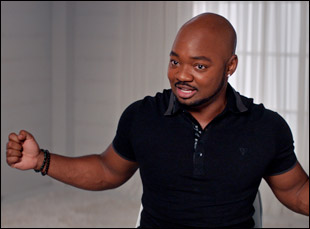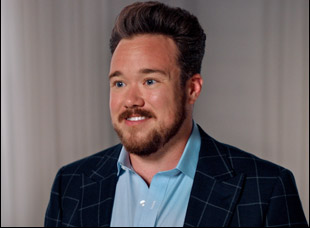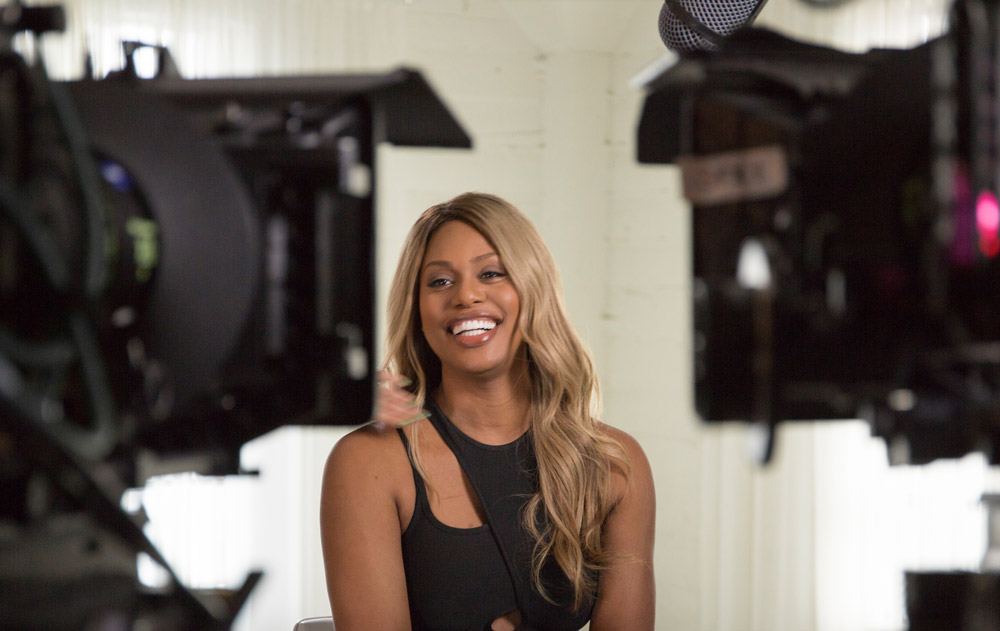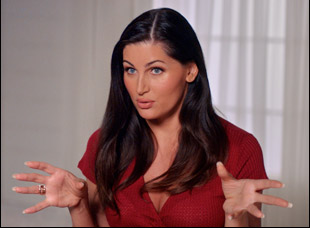It would be a daunting prospect for any filmmaker to sift through a hundred years-plus of filmed entertainment to search for examples of how the transgender experience had been depicted on screen, but for Sam Feder, it was particularly tough when he had long ago turned off his TV in disgust.
“I really have rejected dominant mainstream media because I have found it so problematic for so many reasons for so long,” says the director of “Disclosure,” a comprehensive and engaging history of trans representation on screen which debuts on Netflix this week. “So being forced back into that viewing experience did surprise me — early on, I expected this film to look beyond Hollywood film and TV at more international, more independent and more documentary examples because that’s the world I’ve been living in, but I realized [the mainstream] had been the most impactful to people and that had influenced the majority of people that I wanted to speak to and speak about.”
That critical eye proves invaluable to “Disclosure,” which becomes a personal history as much as a cultural one when so many in the trans community internalized the images they saw and have turned it into fuel to transcend the negative stereotypes that have been been perpetuated over the years. Traveling all the way back to the days of silent films to find that one of cinema’s most reliable sight gags has been to have men dressed up as women, the film tracks the consequences of being seen in society exclusively as the butt of a joke before even more pernicious portrayals took hold, with “Orange is the New Black” star Laverne Cox lamenting how damaging it was to see people dressed as the opposite sex to gain an advantage on “Bosom Buddies” and “Tootsie” when it couldn’t be further from reality and often acts as a tool of belittlement to reaffirm the place of white cisgender males’ dominant place in the culture. (Lilly Wachowski has to resort to Bugs Bunny cartoons to think of seeing a positive example in her youth.)
While a variety of trans filmmakers reflect on the past, their mere presence in “Disclosure” speaks to the future in which they’re more involved in telling their own stories and although the film rarely cites statistics when the details of its subjects’ personal experience more than prove their point, the realization that 80 percent of Americans don’t know a transgender person, making what they see in TV and movies their only exposure illuminates the power the media continues to have in shaping how the public’s acceptance of the community. Like the films that inspired Feder to connect the images we see and the cultural attitudes that have birthed them, “Disclosure” is bound to become an essential reference, making its widespread availability this week particularly special, but it also offers the spotlight to so many trans actors, actresses and directors that rarely have been able to take center stage and on the eve of the film’s release, the filmmaker spoke about empower trans people in front of and behind the camera to share their perspective and compiling a history that may be difficult to watch at times, but shows the missteps that can contribute to growth.
I think that by looking at the past, we can really understand the present and plan better for the future, and there were two documentaries that really changed my life – “The Celluloid Closet” and “Ethnic Notions,” so I always wanted to see the history of trans people with that sort of critique and analysis. Here we were in 2014, or there we were in 2014, when trans visibility was increasing and mainstream society was talking about us more than ever and I really wanted to give trans and non-trans people alike more context to understand the changes in our culture, the history and how we got to this point of visibility. I also didn’t want to lose sight of the fact that visibility is in itself not the goal. It’s a means to an end, so I knew there was a lot more to this story than what the public was seeing and I wanted to tell that story.
Jen Richards says something towards the beginning that seemed like it might’ve been a way into the film for you – “Every trans person carries with them a history of trans representation.” Did you find there was a common currency amongst the people you spoke to to give this shape?
For better or for worse, the common thread was Hollywood. When I set out to make this film, I expected it to go beyond Hollywood, but everyone goes back to the images they saw growing up on film and television and how they’ve lasted over the years. That is such a common experience for people in our culture to reference Hollywood and that’s what I saw again and again. It depends on the generation [what the touchstones are] — talk shows, as you see in the film, were so influential who are in their thirties and forties now and what is the relationship between the fictionalized staged parts of talk shows and the real lived lives of people who log off and have to deal with what has happened on those shows and then as a viewer, what is your relationship with laughing at or laughing with being part this sort of disidentification that happens.
But there’s such a love/hate with all of these images. Rain [Valdez] talks about watching “Soapdish” with her family and she still says she loves that film [which has a gender reveal in it], but it deeply impacted her identity at the time and [there was] the fear that she and her parents carried from that moment on, so what was so interesting to me is how none of this is cut and dry. It’s so complicated. Our culture really likes to distill things into a black-and-white narrative, and good versus bad. That is such a disservice to telling a history.

Oh yeah, I constantly thought about, “Is this film going to retraumatize people? and “Am I just furthering the harm that has already been done?” What I realized is that for me, and I’ve heard this again and again for other people, is that when you see these images that you have internalized for so long – the hate, the shame, the violence, the dehumanization that you’ve come to believe about yourself or somebody else — molecules shift when you see it outside of yourself. When you see it in a particular context, being held and told to you by these brilliant trans people, there’s this ownership, there’s this empowerment that really allows you to move past it in a way you hadn’t before.
It actually becomes moving when you see trans actors and actresses talk about the times they’ve had to portray a stereotype in order to keep working, like the scene where Candis Cayne is describing her appearance as a dead sex worker on “CSI: NY.” Still, were those difficult conversations to have?
I never blame the actors. The actors need work and these problems start way before they’re on set. I think actors are now more empowered to push back, especially depending on what kind of privilege you walk into the audition with — a lot of people push back at auditions now. But often, this just wasn’t a possibility. You need to pay your rent. So I don’t blame the actors and I made that very clear doing all these interviews. It was never going to be framed as a way to demonize people for doing work. This is about looking at what has happened in the writer’s room, what happened when the producers are having conversations, and what happened when the director is mapping out the shoot.

Yes, it was very challenging and I can’t wait to see all the different ways people tell this story because there are so many ways to look at it. It’s so ethically precarious to tell a history, so from the beginning, the research was done with around 80 different trans people that I did really in-depth research and reviews in order to compile the database of material that we looked at, but because it was the first, I wanted to really rely on personal experiences [since] you can’t really refute personal experience. You can’t get more real than what someone has experienced themselves.
How did the process of collecting interviews and research interact with each other? Was it going on in tandem?
[When] I did the initial research and got to see the touchstones and how different films were also reflecting what was happening off the screen, [you could see] there’s the touchstones of what’s happening in the film world and there’s the touchstones of what’s happening off the screen and how the film world is mirroring that. Then there were the touchstones of what was happening in trans history and then there’s the touchstones of what people remembered collectively, [so] that was constantly evolving and being built upon, and our team never shied away from looking at new material, finding new material and adding new material up until the last minute.I had an incredible editor Stacy Goldate was very experienced with archival footage and she and her assistant spent a lot of time going through these clips and pulling out examples, and while the material was so distorted and painful at times to look at, I enjoyed that process myself too. I spent so many years getting these clips and it was film history for myself, just getting to watch things that I could never make the time before to watch for one reason or another. Once you’re desensitized from the content, it becomes this little bit of a treasure hunt where you’re scanning the footage for that right clip and it’s so satisfying when you finally land on it and it works so beautifully with the interviews.

That’s come with time as a filmmaker. This is my third feature documentary and you really learn along the way how to create that comfort and how to give people that time – that silence is wonderful and it can be really impactful to hold and not constantly keep the conversation going. Sometimes when you hold silence for a few beats, the person comes in with something that you never would’ve thought to ask, so I appreciate you noticing that as something that I try to be really intentional about. The aesthetic is also speaking to that. It was really important that the people I interviewed would be foregrounded. I didn’t want there to be any distraction and I wanted the space to feel expansive – to be elegant and beautiful and give everyone breathing space because the content of the footage was so heavy and so busy.
This is going out into the world in strange times, but you at least were able to get to have a big premiere at Sundance. What’s it been like to have it released?
Sundance was incredible. One of the highlights was having [Sundance Director of Programming] Kim Yutani introduce this film and say it’s one of the highlights of her career. That just blew me away. And we were so excited and ready to travel with the film all over. We were ready to go to Copenhagen and Greece and London and we were going to be in New York for our Tribeca premiere. Then of course, the pandemic hit, so there was a lot of grief and a lot of loss and a lot of fear, both personally and involving the film, so we really didn’t know where we would land, but having these conversations and being on Netflix is really just such the perfect home [because] it’s a global audience that Netflix has in 191 countries. That’s mind boggling and we are trying to figure out ways for communities that can’t access Netflix to see the film as well.

“Disclosure” is now streaming on Netflix.





